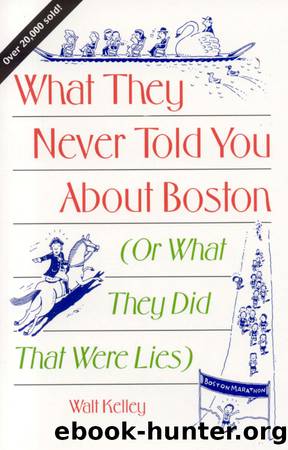What They Never Told You About Boston by Walt Kelley

Author:Walt Kelley
Language: eng
Format: epub
ISBN: 9781608932733
Publisher: Down East Books
Published: 2014-08-06T00:00:00+00:00
14
Liberty Square
ON JANUARY 24, 1793, one of the biggest, longest, and rowdiest parties in the history of Boston took place. It began in what was then a residential (now commercial) area of the city, at the intersection of Kilby, Water, and Batterymarch streets. The celebration was in honor of the French Revolution.
Bostonians recognize and will be ever grateful for the fact that without the assistance of the French, American Independence might never have been achieved. Most fondly remembered and revered is the Marquis de Lafayette. He withdrew his commission from the military service of his own country in 1777 and came to the Colonies in his own ship to volunteer his services to General George Washington in any capacity and without pay. Most Bostonians know that the city has named Avenue de Lafayette and Lafayette Place in his honor, as well as Fayette Court and Fayette Street. But even Bostonians have never been told that LaGrange Street, between Boylston and Stuart streets in the downtown theater district, LaGrange Place in Roxbury, and LaGrange Street in West Roxbury also honor General Lafayette. LaGrange, you see, was the marquisâ summer estate in the south of France.
When Lafayette toured what were the original thirteen states in his final visit to America (after laying the cornerstone of the Bunker Hill Monument in 1824), the crowds were, in many instances, larger than when President George Washington made his final tour in 1789. Even now, every year on July 14, Boston closes down a section of Marlboro Street near the French Library and celebrates Bastille Day. A stately dinner of haute cuisine is followed by dancing until the wee hours, both indoors and out.
Back in 1793, these feelings were even more pronounced than they are today, and they were universally shared. So when the news arrived that the French were close to winning their own liberty, equality, and fraternity, a spontaneous emotion of kindred spirit exploded in Boston.
An ox weighing over one thousand pounds was barbecued somewhere nearby, hoisted onto a wagon, and brought to the open area where Kilby, Water, and Batterymarch streets intersected. Someone mounted the ox horns on a sixty-foot rod and raised a âliberty poleâ to the French. Another cart appeared carrying eight hundred loaves of bread, then still another loaded with hogsheads of very potent punch. The revelers then decided to parade through the entire city and stop at the homes of Governor John Hancock, Lieutenant Governor Samuel Adams, and anyone else they could think of with whom to raise a toast of good cheer. The parade lasted all day and well into the next morning. It was estimated that fully one half of the population got drunk also.
When the French Revolution ended, Bostonians in their euphoria declared the confluence of the three streets to be Liberty Square. Unfortunately, over the years, later generations have forgotten this unprecedented event in their history and in ignorance have associated Liberty Square with American independence, not with the French Revolution.
And in 1992 the city decided to honor (and rightly so) the freedom fighters in Hungary.
Download
This site does not store any files on its server. We only index and link to content provided by other sites. Please contact the content providers to delete copyright contents if any and email us, we'll remove relevant links or contents immediately.
| Americas | African Americans |
| Civil War | Colonial Period |
| Immigrants | Revolution & Founding |
| State & Local |
In Cold Blood by Truman Capote(3311)
The Innovators: How a Group of Hackers, Geniuses, and Geeks Created the Digital Revolution by Walter Isaacson(2849)
Steve Jobs by Walter Isaacson(2836)
All the President's Men by Carl Bernstein & Bob Woodward(2329)
Lonely Planet New York City by Lonely Planet(2172)
And the Band Played On by Randy Shilts(2131)
The Room Where It Happened by John Bolton;(2105)
The Poisoner's Handbook by Deborah Blum(2093)
The Murder of Marilyn Monroe by Jay Margolis(2059)
The Innovators by Walter Isaacson(2056)
Lincoln by David Herbert Donald(1945)
A Colony in a Nation by Chris Hayes(1881)
Under the Banner of Heaven: A Story of Violent Faith by Jon Krakauer(1750)
Amelia Earhart by Doris L. Rich(1650)
The Unsettlers by Mark Sundeen(1647)
Being George Washington by Beck Glenn(1623)
Birdmen by Lawrence Goldstone(1621)
Dirt by Bill Buford(1612)
Zeitoun by Dave Eggers(1593)
